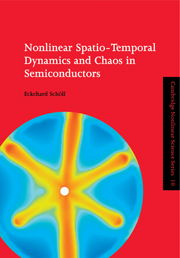Book contents
- Frontmatter
- Contents
- Preface
- Chapter 1 Semiconductors as continuous nonlinear dynamic systems
- Chapter 2 Concepts of nonlinear charge transport in semiconductors
- Chapter 3 Pattern formation and oscillatory instabilities in semiconductors
- Chapter 4 Impact-ionization-induced impurity breakdown
- Chapter 5 Nonlinear carrier dynamics in crossed electric and magnetic fields
- Chapter 6 Stationary and oscillating domains in superlattices
- Chapter 7 Spatio-temporal chaos
- References
- Index
Chapter 2 - Concepts of nonlinear charge transport in semiconductors
Published online by Cambridge University Press: 17 September 2009
- Frontmatter
- Contents
- Preface
- Chapter 1 Semiconductors as continuous nonlinear dynamic systems
- Chapter 2 Concepts of nonlinear charge transport in semiconductors
- Chapter 3 Pattern formation and oscillatory instabilities in semiconductors
- Chapter 4 Impact-ionization-induced impurity breakdown
- Chapter 5 Nonlinear carrier dynamics in crossed electric and magnetic fields
- Chapter 6 Stationary and oscillating domains in superlattices
- Chapter 7 Spatio-temporal chaos
- References
- Index
Summary
The theory of electric transport in semiconductors describes how charge carriers interact with electric and magnetic fields, and move under their influence. In general, we will consider the regime far from thermodynamic equilibrium, under which linear relations between current and voltage do not hold, and more sophisticated modeling of the microscopic charge-transport processes is required. There are various levels at which semiconductor transport can be modeled, depending upon the specific structures under consideration as well as the operating conditions. In this chapter we will survey a hierarchy of approaches to nonlinear charge transport and discuss the regimes of validity. This hierarchy of models will form the physical basis for the instabilities and spatio-temporal pattern formation processes to be discussed in the subsequent chapters. It will also serve to introduce some systematics and give guidance concerning the confusing variety of nonlinear dynamic models that have been developed and studied in the field of semiconductor instabilities within the recent past.
Introduction
With the advent of modern semiconductor-growth technologies such as molecular beam epitaxy (MBE) and metal–organic chemical vapor deposition (MOCVD), artificial structures composed of different materials with layer widths of only a few nanometers have been grown, and additional lateral patterning by electron-beam lithography or other lithographic or etching techniques (ion-beam, X-ray, and scanning-probe microscopies) can impose lateral dimensions of quantum confinement in the 10 nm regime. Alternatively, lateral structures can be induced by the Stranski–Krastanov growth mode in strained material systems, which leads to the self-organized formation of islands (“quantum dots”) a few nanometers in diameter (Bimberg et al. 1999).
- Type
- Chapter
- Information
- Publisher: Cambridge University PressPrint publication year: 2001



